Walden University: TANF Social Policy Analysis and Recommendations
VerifiedAdded on 2023/01/11
|7
|1960
|89
Report
AI Summary
This report provides a comprehensive analysis of the Temporary Assistance for Needy Families (TANF) program, focusing on its role in addressing social issues, particularly homelessness. It begins by outlining the current policy approach, eligibility criteria, and the program's goals, which include providing financial assistance to needy families and promoting self-sufficiency. The report then delves into the funding levels of TANF, highlighting the stagnation of funding and its impact on the program's ability to reach those in need. It examines the population covered by the policy and identifies at-risk populations affected by the program. The analysis also explores the policy's shortcomings, such as its failure to adequately address the needs of two-parent families and its inflexibility during economic downturns. Finally, the report offers recommendations for alternative policies, including expanding eligibility criteria, increasing funding, and adapting the program to address contemporary social challenges, such as migration and globalization, to better serve the needs of vulnerable populations.

Paraphrase This Document
Need a fresh take? Get an instant paraphrase of this document with our AI Paraphraser
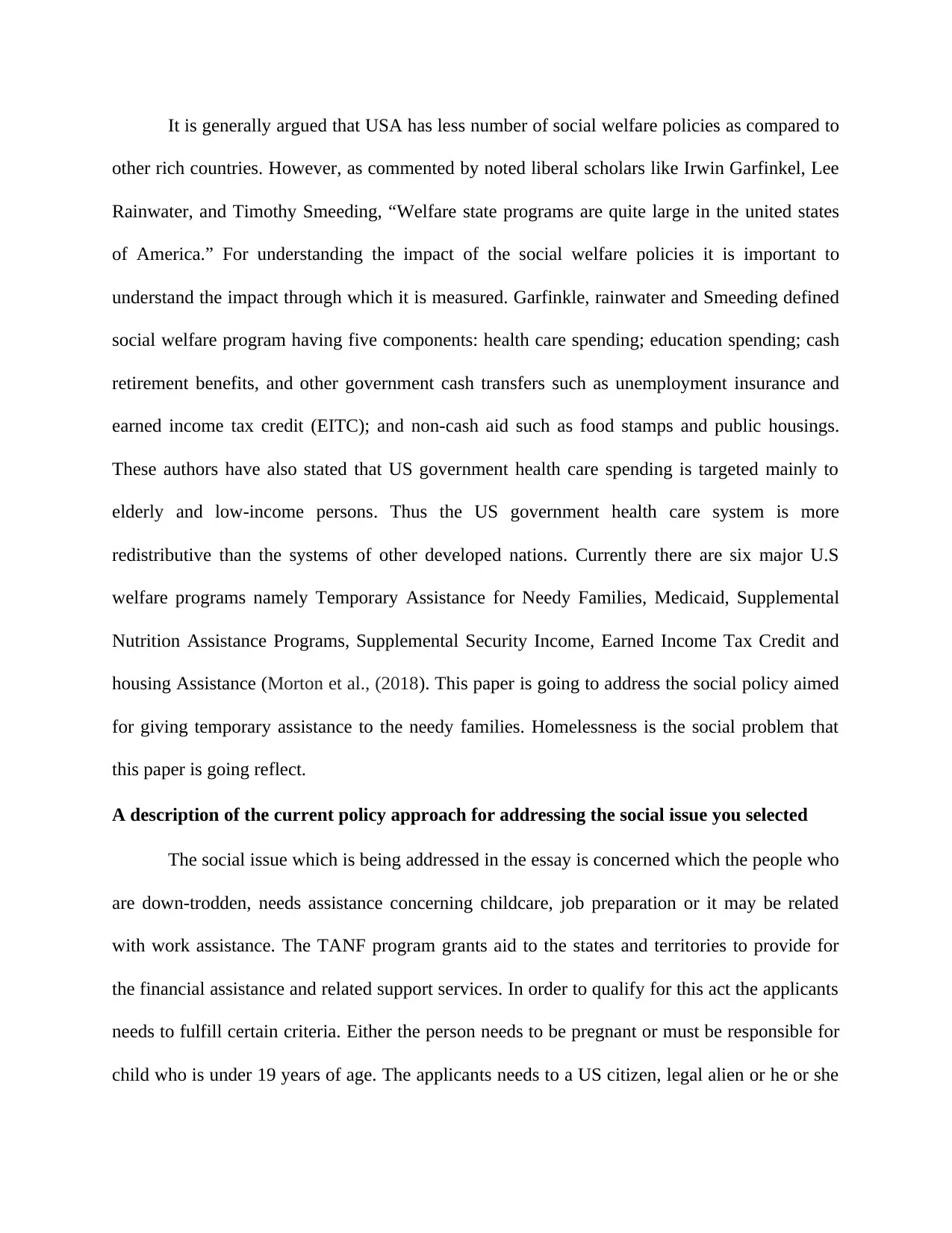
It is generally argued that USA has less number of social welfare policies as compared to
other rich countries. However, as commented by noted liberal scholars like Irwin Garfinkel, Lee
Rainwater, and Timothy Smeeding, “Welfare state programs are quite large in the united states
of America.” For understanding the impact of the social welfare policies it is important to
understand the impact through which it is measured. Garfinkle, rainwater and Smeeding defined
social welfare program having five components: health care spending; education spending; cash
retirement benefits, and other government cash transfers such as unemployment insurance and
earned income tax credit (EITC); and non-cash aid such as food stamps and public housings.
These authors have also stated that US government health care spending is targeted mainly to
elderly and low-income persons. Thus the US government health care system is more
redistributive than the systems of other developed nations. Currently there are six major U.S
welfare programs namely Temporary Assistance for Needy Families, Medicaid, Supplemental
Nutrition Assistance Programs, Supplemental Security Income, Earned Income Tax Credit and
housing Assistance (Morton et al., (2018). This paper is going to address the social policy aimed
for giving temporary assistance to the needy families. Homelessness is the social problem that
this paper is going reflect.
A description of the current policy approach for addressing the social issue you selected
The social issue which is being addressed in the essay is concerned which the people who
are down-trodden, needs assistance concerning childcare, job preparation or it may be related
with work assistance. The TANF program grants aid to the states and territories to provide for
the financial assistance and related support services. In order to qualify for this act the applicants
needs to fulfill certain criteria. Either the person needs to be pregnant or must be responsible for
child who is under 19 years of age. The applicants needs to a US citizen, legal alien or he or she
other rich countries. However, as commented by noted liberal scholars like Irwin Garfinkel, Lee
Rainwater, and Timothy Smeeding, “Welfare state programs are quite large in the united states
of America.” For understanding the impact of the social welfare policies it is important to
understand the impact through which it is measured. Garfinkle, rainwater and Smeeding defined
social welfare program having five components: health care spending; education spending; cash
retirement benefits, and other government cash transfers such as unemployment insurance and
earned income tax credit (EITC); and non-cash aid such as food stamps and public housings.
These authors have also stated that US government health care spending is targeted mainly to
elderly and low-income persons. Thus the US government health care system is more
redistributive than the systems of other developed nations. Currently there are six major U.S
welfare programs namely Temporary Assistance for Needy Families, Medicaid, Supplemental
Nutrition Assistance Programs, Supplemental Security Income, Earned Income Tax Credit and
housing Assistance (Morton et al., (2018). This paper is going to address the social policy aimed
for giving temporary assistance to the needy families. Homelessness is the social problem that
this paper is going reflect.
A description of the current policy approach for addressing the social issue you selected
The social issue which is being addressed in the essay is concerned which the people who
are down-trodden, needs assistance concerning childcare, job preparation or it may be related
with work assistance. The TANF program grants aid to the states and territories to provide for
the financial assistance and related support services. In order to qualify for this act the applicants
needs to fulfill certain criteria. Either the person needs to be pregnant or must be responsible for
child who is under 19 years of age. The applicants needs to a US citizen, legal alien or he or she
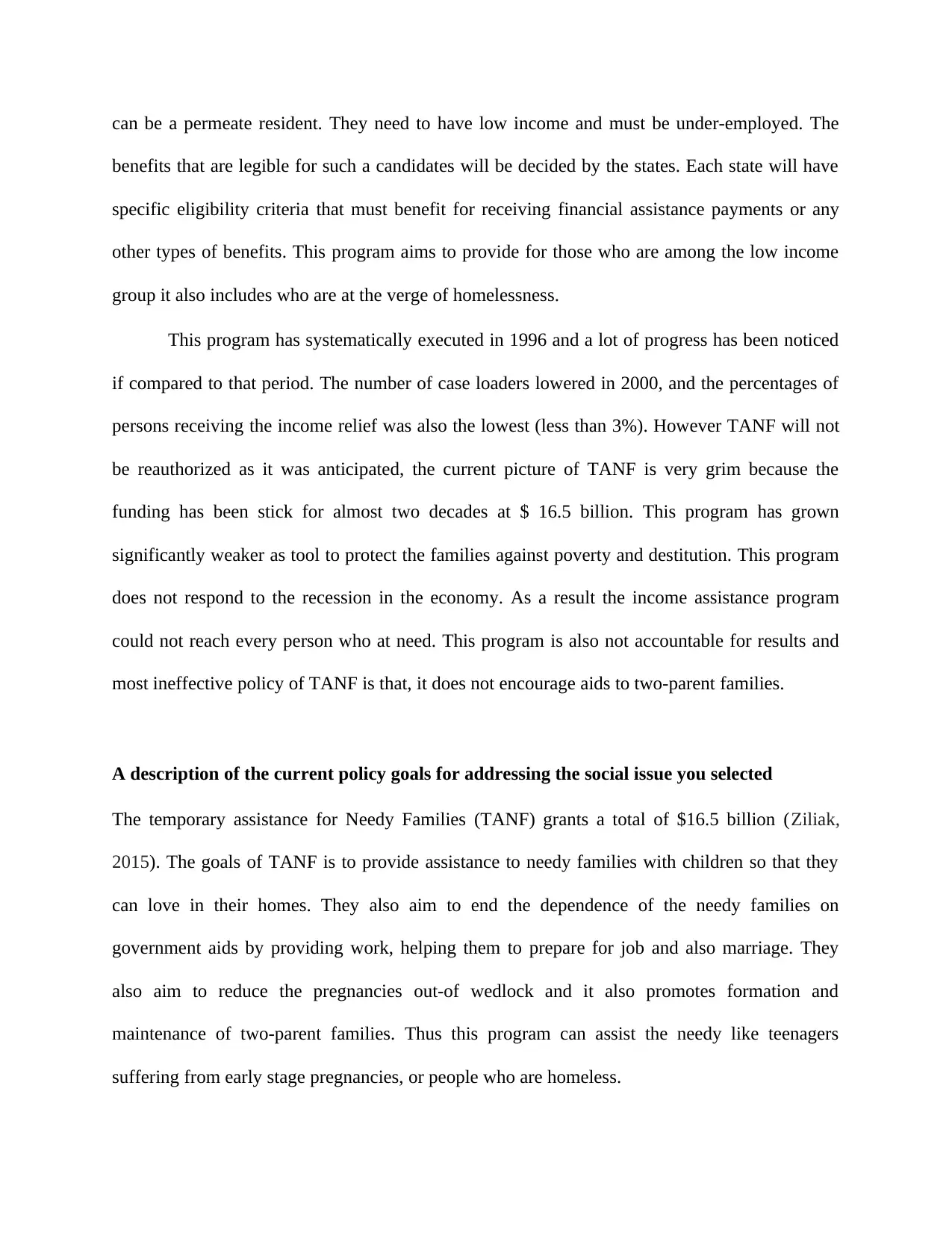
can be a permeate resident. They need to have low income and must be under-employed. The
benefits that are legible for such a candidates will be decided by the states. Each state will have
specific eligibility criteria that must benefit for receiving financial assistance payments or any
other types of benefits. This program aims to provide for those who are among the low income
group it also includes who are at the verge of homelessness.
This program has systematically executed in 1996 and a lot of progress has been noticed
if compared to that period. The number of case loaders lowered in 2000, and the percentages of
persons receiving the income relief was also the lowest (less than 3%). However TANF will not
be reauthorized as it was anticipated, the current picture of TANF is very grim because the
funding has been stick for almost two decades at $ 16.5 billion. This program has grown
significantly weaker as tool to protect the families against poverty and destitution. This program
does not respond to the recession in the economy. As a result the income assistance program
could not reach every person who at need. This program is also not accountable for results and
most ineffective policy of TANF is that, it does not encourage aids to two-parent families.
A description of the current policy goals for addressing the social issue you selected
The temporary assistance for Needy Families (TANF) grants a total of $16.5 billion (Ziliak,
2015). The goals of TANF is to provide assistance to needy families with children so that they
can love in their homes. They also aim to end the dependence of the needy families on
government aids by providing work, helping them to prepare for job and also marriage. They
also aim to reduce the pregnancies out-of wedlock and it also promotes formation and
maintenance of two-parent families. Thus this program can assist the needy like teenagers
suffering from early stage pregnancies, or people who are homeless.
benefits that are legible for such a candidates will be decided by the states. Each state will have
specific eligibility criteria that must benefit for receiving financial assistance payments or any
other types of benefits. This program aims to provide for those who are among the low income
group it also includes who are at the verge of homelessness.
This program has systematically executed in 1996 and a lot of progress has been noticed
if compared to that period. The number of case loaders lowered in 2000, and the percentages of
persons receiving the income relief was also the lowest (less than 3%). However TANF will not
be reauthorized as it was anticipated, the current picture of TANF is very grim because the
funding has been stick for almost two decades at $ 16.5 billion. This program has grown
significantly weaker as tool to protect the families against poverty and destitution. This program
does not respond to the recession in the economy. As a result the income assistance program
could not reach every person who at need. This program is also not accountable for results and
most ineffective policy of TANF is that, it does not encourage aids to two-parent families.
A description of the current policy goals for addressing the social issue you selected
The temporary assistance for Needy Families (TANF) grants a total of $16.5 billion (Ziliak,
2015). The goals of TANF is to provide assistance to needy families with children so that they
can love in their homes. They also aim to end the dependence of the needy families on
government aids by providing work, helping them to prepare for job and also marriage. They
also aim to reduce the pregnancies out-of wedlock and it also promotes formation and
maintenance of two-parent families. Thus this program can assist the needy like teenagers
suffering from early stage pregnancies, or people who are homeless.
⊘ This is a preview!⊘
Do you want full access?
Subscribe today to unlock all pages.

Trusted by 1+ million students worldwide
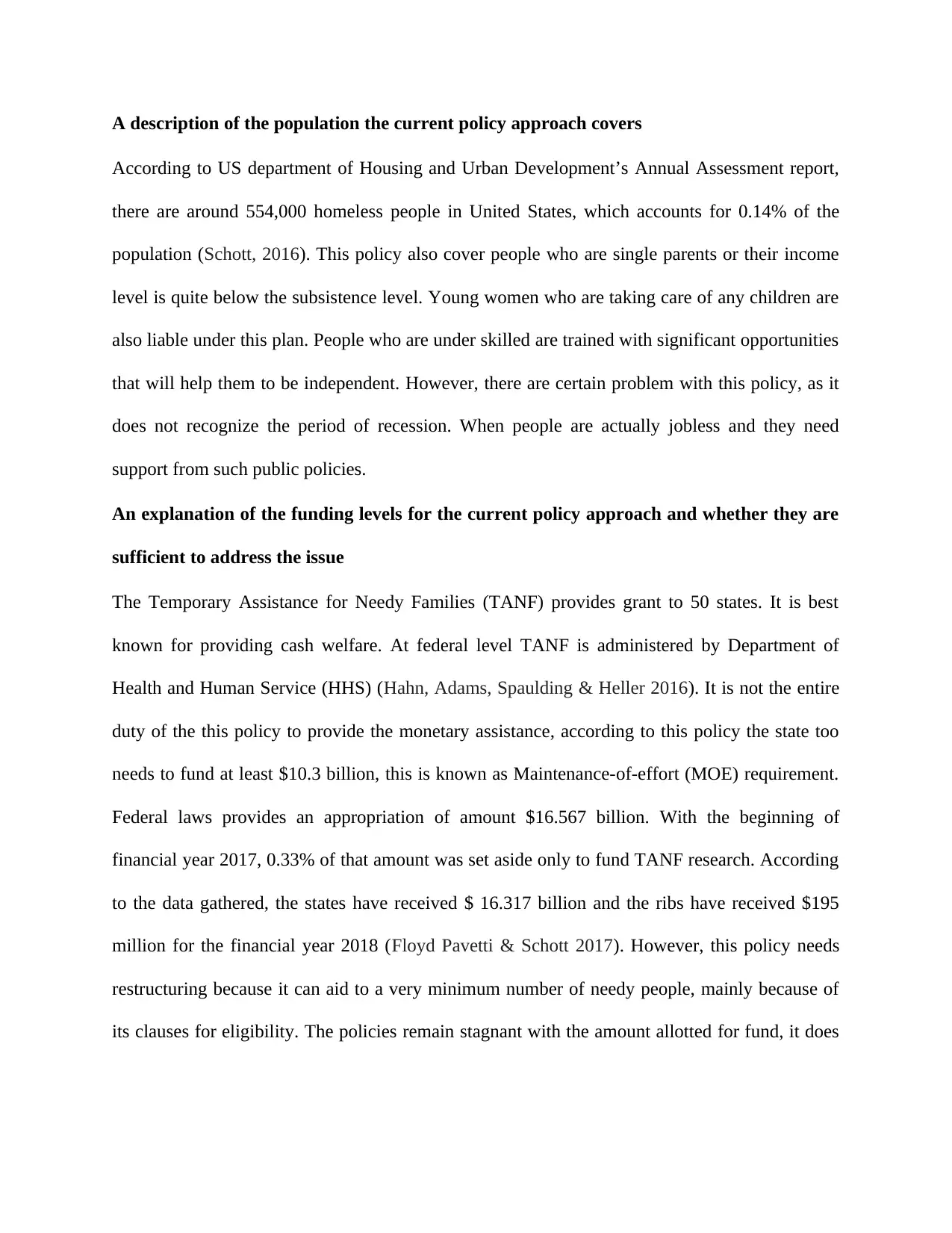
A description of the population the current policy approach covers
According to US department of Housing and Urban Development’s Annual Assessment report,
there are around 554,000 homeless people in United States, which accounts for 0.14% of the
population (Schott, 2016). This policy also cover people who are single parents or their income
level is quite below the subsistence level. Young women who are taking care of any children are
also liable under this plan. People who are under skilled are trained with significant opportunities
that will help them to be independent. However, there are certain problem with this policy, as it
does not recognize the period of recession. When people are actually jobless and they need
support from such public policies.
An explanation of the funding levels for the current policy approach and whether they are
sufficient to address the issue
The Temporary Assistance for Needy Families (TANF) provides grant to 50 states. It is best
known for providing cash welfare. At federal level TANF is administered by Department of
Health and Human Service (HHS) (Hahn, Adams, Spaulding & Heller 2016). It is not the entire
duty of the this policy to provide the monetary assistance, according to this policy the state too
needs to fund at least $10.3 billion, this is known as Maintenance-of-effort (MOE) requirement.
Federal laws provides an appropriation of amount $16.567 billion. With the beginning of
financial year 2017, 0.33% of that amount was set aside only to fund TANF research. According
to the data gathered, the states have received $ 16.317 billion and the ribs have received $195
million for the financial year 2018 (Floyd Pavetti & Schott 2017). However, this policy needs
restructuring because it can aid to a very minimum number of needy people, mainly because of
its clauses for eligibility. The policies remain stagnant with the amount allotted for fund, it does
According to US department of Housing and Urban Development’s Annual Assessment report,
there are around 554,000 homeless people in United States, which accounts for 0.14% of the
population (Schott, 2016). This policy also cover people who are single parents or their income
level is quite below the subsistence level. Young women who are taking care of any children are
also liable under this plan. People who are under skilled are trained with significant opportunities
that will help them to be independent. However, there are certain problem with this policy, as it
does not recognize the period of recession. When people are actually jobless and they need
support from such public policies.
An explanation of the funding levels for the current policy approach and whether they are
sufficient to address the issue
The Temporary Assistance for Needy Families (TANF) provides grant to 50 states. It is best
known for providing cash welfare. At federal level TANF is administered by Department of
Health and Human Service (HHS) (Hahn, Adams, Spaulding & Heller 2016). It is not the entire
duty of the this policy to provide the monetary assistance, according to this policy the state too
needs to fund at least $10.3 billion, this is known as Maintenance-of-effort (MOE) requirement.
Federal laws provides an appropriation of amount $16.567 billion. With the beginning of
financial year 2017, 0.33% of that amount was set aside only to fund TANF research. According
to the data gathered, the states have received $ 16.317 billion and the ribs have received $195
million for the financial year 2018 (Floyd Pavetti & Schott 2017). However, this policy needs
restructuring because it can aid to a very minimum number of needy people, mainly because of
its clauses for eligibility. The policies remain stagnant with the amount allotted for fund, it does
Paraphrase This Document
Need a fresh take? Get an instant paraphrase of this document with our AI Paraphraser
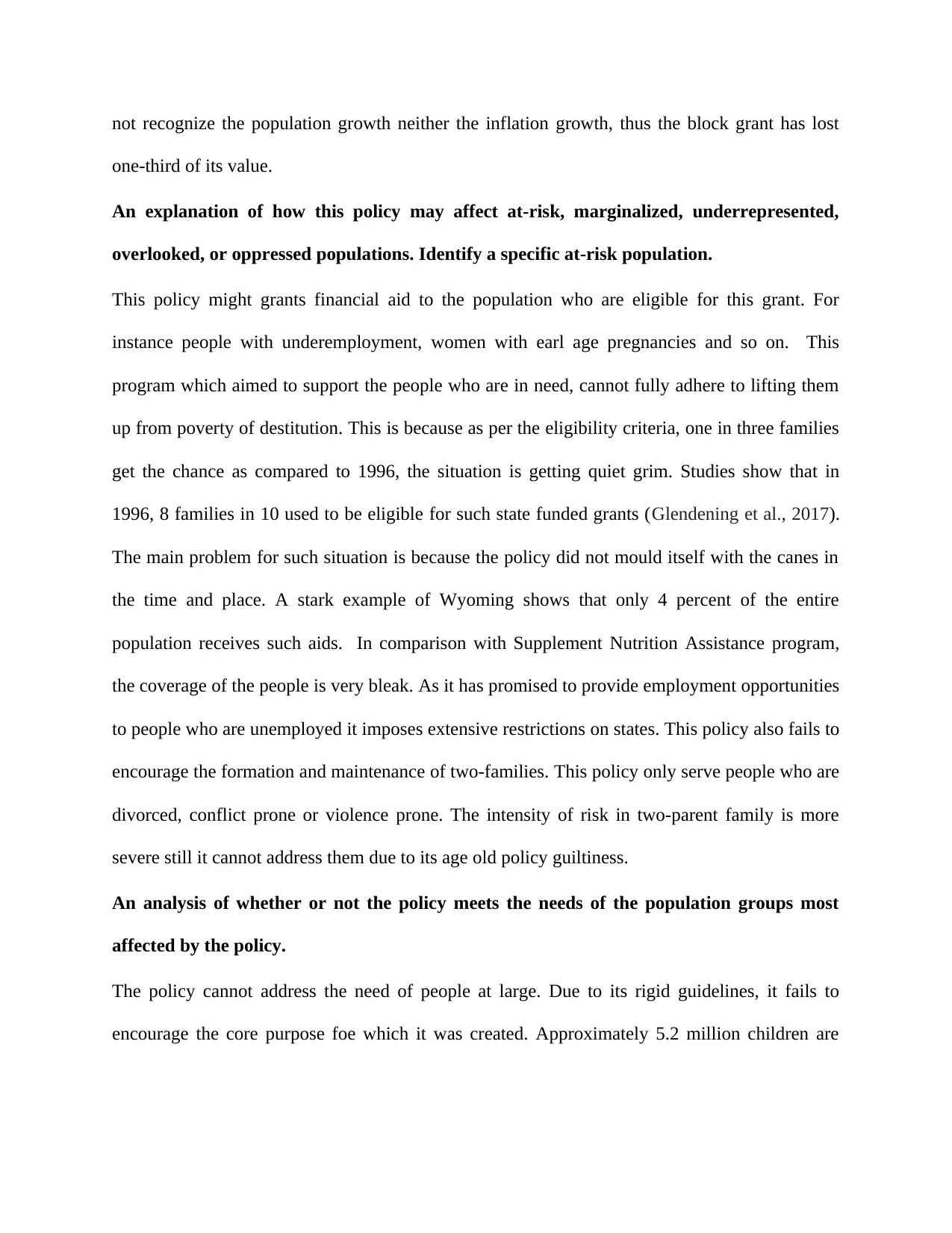
not recognize the population growth neither the inflation growth, thus the block grant has lost
one-third of its value.
An explanation of how this policy may affect at-risk, marginalized, underrepresented,
overlooked, or oppressed populations. Identify a specific at-risk population.
This policy might grants financial aid to the population who are eligible for this grant. For
instance people with underemployment, women with earl age pregnancies and so on. This
program which aimed to support the people who are in need, cannot fully adhere to lifting them
up from poverty of destitution. This is because as per the eligibility criteria, one in three families
get the chance as compared to 1996, the situation is getting quiet grim. Studies show that in
1996, 8 families in 10 used to be eligible for such state funded grants (Glendening et al., 2017).
The main problem for such situation is because the policy did not mould itself with the canes in
the time and place. A stark example of Wyoming shows that only 4 percent of the entire
population receives such aids. In comparison with Supplement Nutrition Assistance program,
the coverage of the people is very bleak. As it has promised to provide employment opportunities
to people who are unemployed it imposes extensive restrictions on states. This policy also fails to
encourage the formation and maintenance of two-families. This policy only serve people who are
divorced, conflict prone or violence prone. The intensity of risk in two-parent family is more
severe still it cannot address them due to its age old policy guiltiness.
An analysis of whether or not the policy meets the needs of the population groups most
affected by the policy.
The policy cannot address the need of people at large. Due to its rigid guidelines, it fails to
encourage the core purpose foe which it was created. Approximately 5.2 million children are
one-third of its value.
An explanation of how this policy may affect at-risk, marginalized, underrepresented,
overlooked, or oppressed populations. Identify a specific at-risk population.
This policy might grants financial aid to the population who are eligible for this grant. For
instance people with underemployment, women with earl age pregnancies and so on. This
program which aimed to support the people who are in need, cannot fully adhere to lifting them
up from poverty of destitution. This is because as per the eligibility criteria, one in three families
get the chance as compared to 1996, the situation is getting quiet grim. Studies show that in
1996, 8 families in 10 used to be eligible for such state funded grants (Glendening et al., 2017).
The main problem for such situation is because the policy did not mould itself with the canes in
the time and place. A stark example of Wyoming shows that only 4 percent of the entire
population receives such aids. In comparison with Supplement Nutrition Assistance program,
the coverage of the people is very bleak. As it has promised to provide employment opportunities
to people who are unemployed it imposes extensive restrictions on states. This policy also fails to
encourage the formation and maintenance of two-families. This policy only serve people who are
divorced, conflict prone or violence prone. The intensity of risk in two-parent family is more
severe still it cannot address them due to its age old policy guiltiness.
An analysis of whether or not the policy meets the needs of the population groups most
affected by the policy.
The policy cannot address the need of people at large. Due to its rigid guidelines, it fails to
encourage the core purpose foe which it was created. Approximately 5.2 million children are
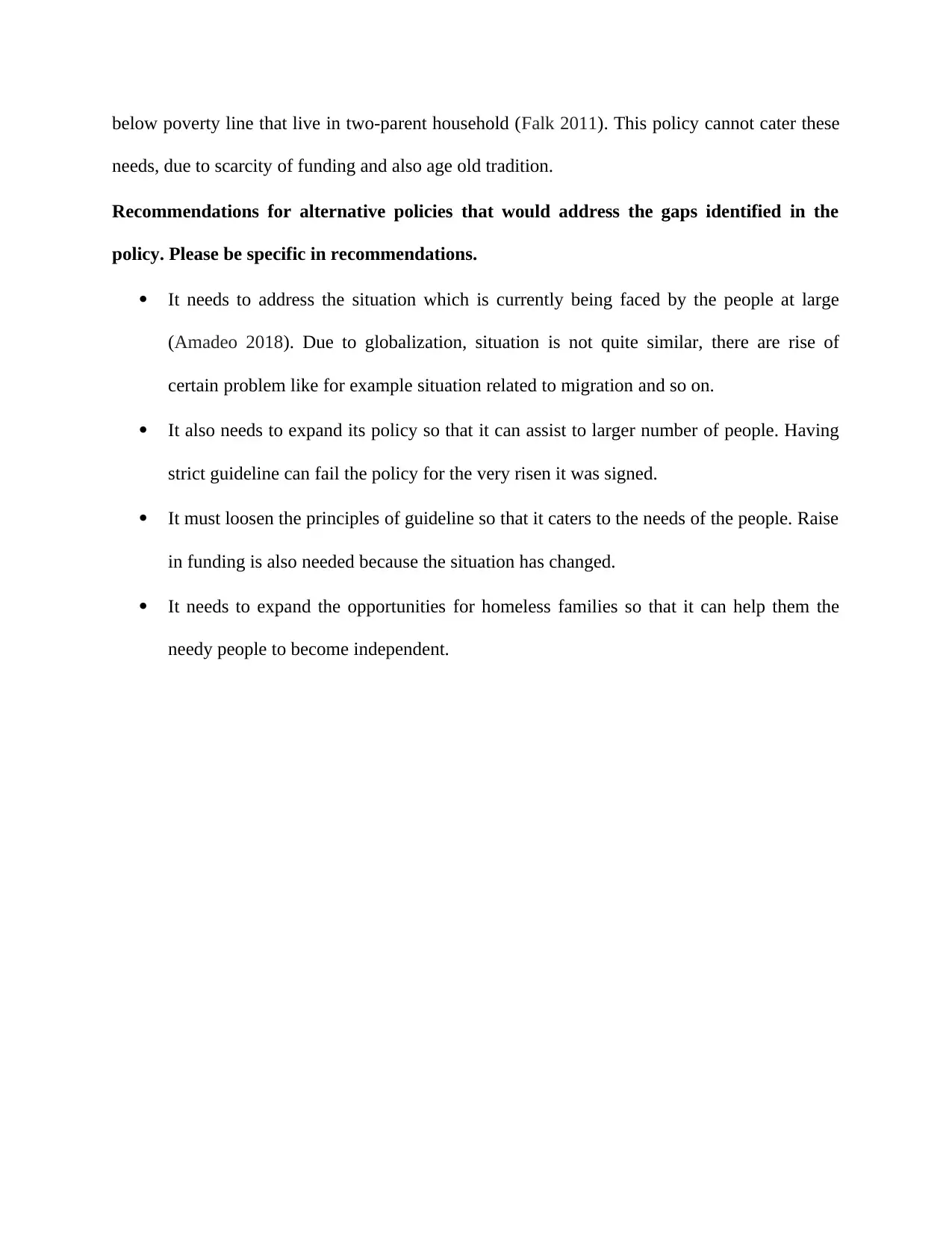
below poverty line that live in two-parent household (Falk 2011). This policy cannot cater these
needs, due to scarcity of funding and also age old tradition.
Recommendations for alternative policies that would address the gaps identified in the
policy. Please be specific in recommendations.
It needs to address the situation which is currently being faced by the people at large
(Amadeo 2018). Due to globalization, situation is not quite similar, there are rise of
certain problem like for example situation related to migration and so on.
It also needs to expand its policy so that it can assist to larger number of people. Having
strict guideline can fail the policy for the very risen it was signed.
It must loosen the principles of guideline so that it caters to the needs of the people. Raise
in funding is also needed because the situation has changed.
It needs to expand the opportunities for homeless families so that it can help them the
needy people to become independent.
needs, due to scarcity of funding and also age old tradition.
Recommendations for alternative policies that would address the gaps identified in the
policy. Please be specific in recommendations.
It needs to address the situation which is currently being faced by the people at large
(Amadeo 2018). Due to globalization, situation is not quite similar, there are rise of
certain problem like for example situation related to migration and so on.
It also needs to expand its policy so that it can assist to larger number of people. Having
strict guideline can fail the policy for the very risen it was signed.
It must loosen the principles of guideline so that it caters to the needs of the people. Raise
in funding is also needed because the situation has changed.
It needs to expand the opportunities for homeless families so that it can help them the
needy people to become independent.
⊘ This is a preview!⊘
Do you want full access?
Subscribe today to unlock all pages.

Trusted by 1+ million students worldwide
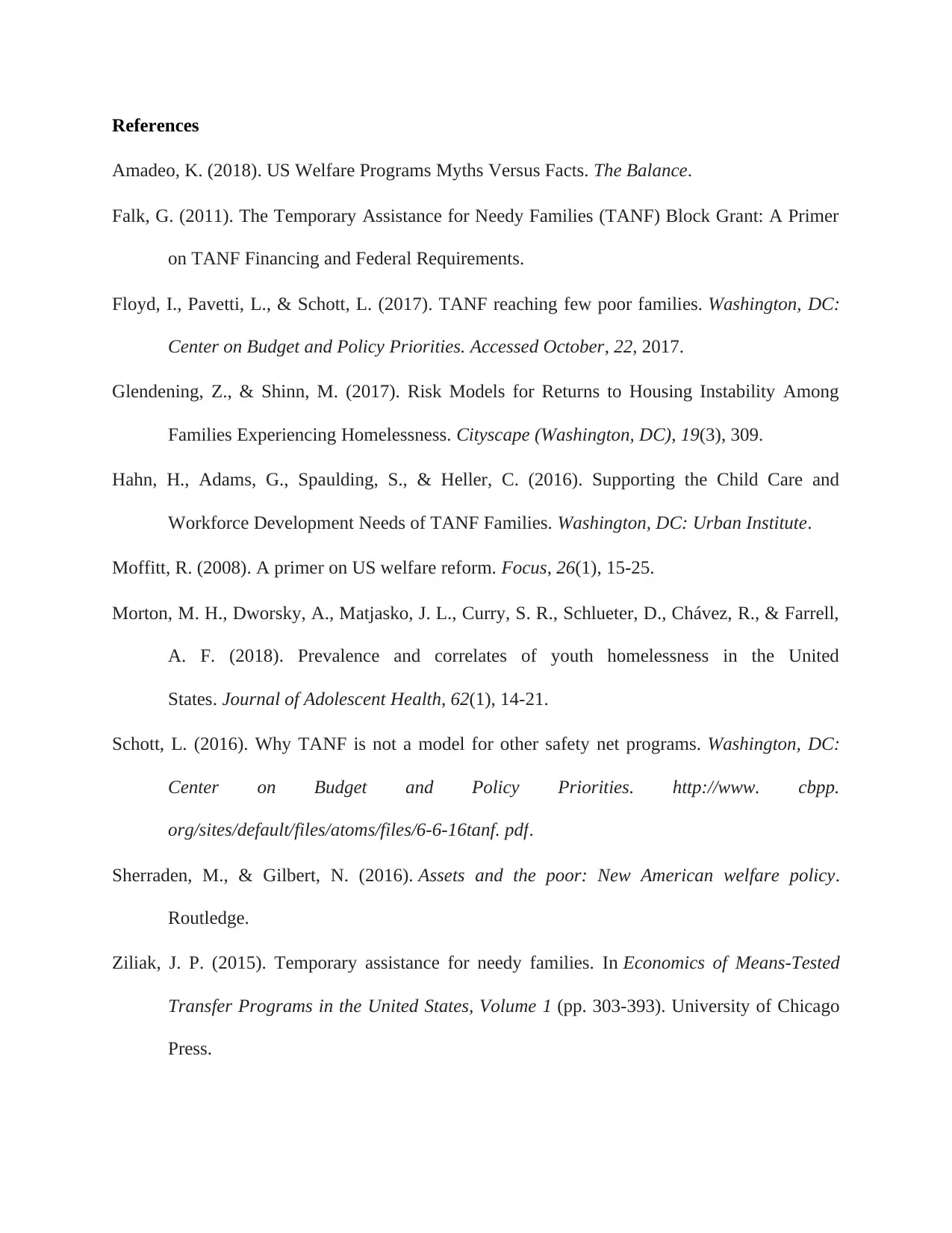
References
Amadeo, K. (2018). US Welfare Programs Myths Versus Facts. The Balance.
Falk, G. (2011). The Temporary Assistance for Needy Families (TANF) Block Grant: A Primer
on TANF Financing and Federal Requirements.
Floyd, I., Pavetti, L., & Schott, L. (2017). TANF reaching few poor families. Washington, DC:
Center on Budget and Policy Priorities. Accessed October, 22, 2017.
Glendening, Z., & Shinn, M. (2017). Risk Models for Returns to Housing Instability Among
Families Experiencing Homelessness. Cityscape (Washington, DC), 19(3), 309.
Hahn, H., Adams, G., Spaulding, S., & Heller, C. (2016). Supporting the Child Care and
Workforce Development Needs of TANF Families. Washington, DC: Urban Institute.
Moffitt, R. (2008). A primer on US welfare reform. Focus, 26(1), 15-25.
Morton, M. H., Dworsky, A., Matjasko, J. L., Curry, S. R., Schlueter, D., Chávez, R., & Farrell,
A. F. (2018). Prevalence and correlates of youth homelessness in the United
States. Journal of Adolescent Health, 62(1), 14-21.
Schott, L. (2016). Why TANF is not a model for other safety net programs. Washington, DC:
Center on Budget and Policy Priorities. http://www. cbpp.
org/sites/default/files/atoms/files/6-6-16tanf. pdf.
Sherraden, M., & Gilbert, N. (2016). Assets and the poor: New American welfare policy.
Routledge.
Ziliak, J. P. (2015). Temporary assistance for needy families. In Economics of Means-Tested
Transfer Programs in the United States, Volume 1 (pp. 303-393). University of Chicago
Press.
Amadeo, K. (2018). US Welfare Programs Myths Versus Facts. The Balance.
Falk, G. (2011). The Temporary Assistance for Needy Families (TANF) Block Grant: A Primer
on TANF Financing and Federal Requirements.
Floyd, I., Pavetti, L., & Schott, L. (2017). TANF reaching few poor families. Washington, DC:
Center on Budget and Policy Priorities. Accessed October, 22, 2017.
Glendening, Z., & Shinn, M. (2017). Risk Models for Returns to Housing Instability Among
Families Experiencing Homelessness. Cityscape (Washington, DC), 19(3), 309.
Hahn, H., Adams, G., Spaulding, S., & Heller, C. (2016). Supporting the Child Care and
Workforce Development Needs of TANF Families. Washington, DC: Urban Institute.
Moffitt, R. (2008). A primer on US welfare reform. Focus, 26(1), 15-25.
Morton, M. H., Dworsky, A., Matjasko, J. L., Curry, S. R., Schlueter, D., Chávez, R., & Farrell,
A. F. (2018). Prevalence and correlates of youth homelessness in the United
States. Journal of Adolescent Health, 62(1), 14-21.
Schott, L. (2016). Why TANF is not a model for other safety net programs. Washington, DC:
Center on Budget and Policy Priorities. http://www. cbpp.
org/sites/default/files/atoms/files/6-6-16tanf. pdf.
Sherraden, M., & Gilbert, N. (2016). Assets and the poor: New American welfare policy.
Routledge.
Ziliak, J. P. (2015). Temporary assistance for needy families. In Economics of Means-Tested
Transfer Programs in the United States, Volume 1 (pp. 303-393). University of Chicago
Press.
1 out of 7
Related Documents
Your All-in-One AI-Powered Toolkit for Academic Success.
+13062052269
info@desklib.com
Available 24*7 on WhatsApp / Email
![[object Object]](/_next/static/media/star-bottom.7253800d.svg)
Unlock your academic potential
Copyright © 2020–2025 A2Z Services. All Rights Reserved. Developed and managed by ZUCOL.





